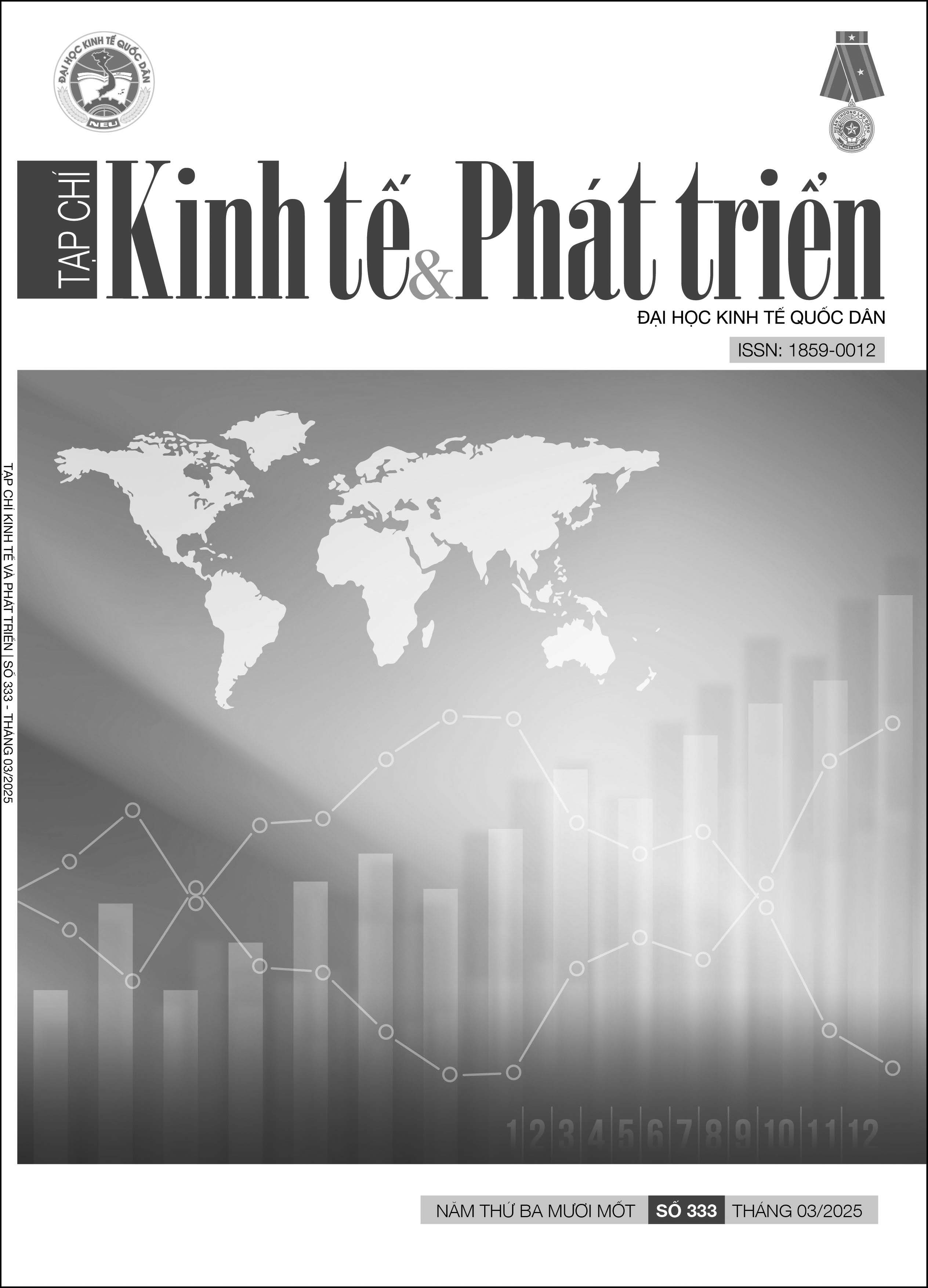Đánh giá tác động của đầu tư trực tiếp nước ngoài đến lượng kiều hối tại các nước Châu Á bằng mô hình hồi quy phân vị
DOI:
https://doi.org/10.33301/JED.VI.1999Từ khóa:
Châu Á, vốn đầu tư trực tiếp nước ngoài, hồi quy phân vị, kiều hốiTóm tắt
Nghiên cứu này sử dụng phương pháp hồi quy phân vị để xem xét tác động của vốn đầu tư trực tiếp nước ngoài (FDI) đến lượng kiều hối ở các phân vị khác nhau tại 47 nước châu Á trong giai đoạn 2010-2022. Bên cạnh FDI, bài viết còn xem xét tác động của một số biến vĩ mô khác đến lượng kiều hối. Kết quả cho thấy ảnh hưởng FDI đến lượng kiều hối không đồng nhất mà phụ thuộc vào mức độ của dòng kiều hối ban đầu của quốc gia. Cụ thể, FDI tác động tích cực đến lượng kiều hối ở mức phân vị thấp, nhưng lại tác động tiêu cực ở các mức phân vị cao. Các yếu tố như GDP, tích lũy tài sản gộp, nợ công đều có mối quan hệ thuận chiều với lượng kiều hối. Trong khi ổn định chính trị lại có mối quan hệ ngược chiều, còn tỷ lệ thất nghiệp và tỷ lệ nghèo có mối quan hệ khá phức tạp. Từ kết quả nghiên cứu, nhóm tác giả gợi ý một số biện pháp giúp các nước châu Á và Việt Nam tăng thu hút nguồn lực từ kiều hối để phát triển kinh tế - xã hội.
Tài liệu tham khảo
Adenutsi, A.E. & Ahortor, C.R.K. (2021), ‘Macroeconomic determinants of remittances flows to sub-Saharan Africa’, African Economic Research Consortium (AERC) Research Paper, 415, 1-38.
Akanbi, B. & Yusuf, A. (2024), ‘Governance quality and remittances in Nigeria: An empirical investigation Sa’ad Babatunde Akanbi’, African Journal of Economic Review, 12(1), https://www.ajol.info/index.php/ajer/article/view/266398/251382.
Alesina, A. & Passalacqua, A. (2015), ‘The political economy of government debt’, NBER working paper series Working Paper 21821, NBER, https://www.nber.org/system/files/working_papers/w21821/w21821.pdf.
Allen, C. (2021), Remittances in Sub-Saharan Africa: An update, from <https://www.imf.org/-/media/Files/Publications/covid19-special-notes/en-special-series-on-covid-19-remittances-in-sub-saharan-africa-an-update.ashx>.
Azizi, S. (2021), ‘The impacts of workers’ remittances on poverty and inequality in developing countries’, Empirical Economics, 60(2), 969-991. https://ideas.repec.org/a/spr/empeco/v60y2021i2d10.1007_s00181-019-01764-8.html.
Baum, A., Checherita-Westphal, C. & Rother, P. (2013), ‘Debt and growth: New evidence for the Euro area’, Journal of International Money and Finance, 32, 809-821. doi:https://doi.org/10.1016/j.jimonfin.2012.07.004.
Chami, R., Fullenkamp, C. & Jahjah, S. (2003), Are immigrant remittances flows source of capital for deveopment?, from <https://www.imf.org/external/pubs/ft/wp/2003/wp03189.pdf>.
Coon, M. & Neumann, R. (2017), ‘Follow the money: Remittance responses to FDI inflows’, Journal of Globalization and Development, 8(2). doi: https://doi.org/10.1515/jgd-2017-0023.
Cristian, I., Incaltarau, C. & Maha, L.G. (2012), ‘The impact of remittances on consumption and investment in Romania’, Eastern Journal of European Studies, 3(2), 61-86. from <https://econpapers.repec.org/article/jesjournl/y_3a2012_3av_3a3_3ap_3a61-86.htm>.
De, S., Islamaj, E., Kose, M.A. & Reza Yousefi, S. (2019), ‘Remittances over the business cycle: Theory and evidence’, Economic Notes: Review of Banking, Finance and Monetary Economics, 48(3), p.e12143.
Jijin, P., Mishra, A.K. & Nithin, M. (2022), ‘Macroeconomic determinants of remittances to India’, Economic Change and Restructuring, 55(2), 1229-1248.
Majaski, C. (2019), What’s the difference between diminishing marginal returns and returns to scale?, from <https://www.investopedia.com/ask/answers/033015/whats-difference-between-diminishing-marginal-returns-and-returns-scale.asp>.
Mustafa, K. & Rashid Ali, S. (2018), The macroeconomic determinants of remittances in Pakistan, from <https://www.academia.edu/download/89838516/24.pdf>.
Nguyen Hieu Huu (2020), ‘Impact of foreign direct investment and international trade on economic growth: Empirical study in Vietnam’, The Journal of Asian Finance, Economics and Business, 7(3), 323-331. doi: https://doi.org/10.13106/jafeb.2020.vol7.no3.323.
Nguyễn Minh Sáng, Bùi Thị Lệ Chi & Nguyễn Thành Nam (2023), ‘Tác động của đầu tư trực tiếp nước ngoài đến tăng trưởng kinh tế Việt Nam’, Tạp chí ngân hàng, from <https://tapchinganhang.gov.vn/tac-dong-cua-dau-tu-truc-tiep-nuoc-ngoai-den-tang-truong-kinh-te-viet-nam.htm>.
Poirine, B. (1997), A theory of remittances as an implicit family loan arrangement, from <https://www.sciencedirect.com/science/article/abs/pii/S0305750X97001216>.
Quadri, A. (2019), Remittances, financial development and economic growth in sub-Saharan African countries: evidence from a PMG-ARDL approach, from <https://ouci.dntb.gov.ua/en/works/9Z3Max37/>.
Ratha, D. (2003), Workers’ remittances: An important and stable source of external development finance, from <https://documents1.worldbank.org/curated/en/698051468128113998/310436360_20050014094932/additional/multi0page.pdf>.
Robert, L., Lucas, R. & Stark, O. (1985), ‘Motivations to remittance: Evidence from Botswana’, Journal of Political Economy, 93(5), 901-918, https://econpapers.repec.org/article/ucpjpolec/v_3a93_3ay_3a1985_3ai_3a5_3ap_3a901-18.htm.
Ruiz-Arranz, P. (2009), ‘Remittances, financial development, and growth’, Journal of Development Economics, 90(1), 144-152, from <https://ideas.repec.org/a/eee/deveco/v90y2009i1p144-152.html>.
Tsaurai, K. & Maseko, C. (2020), An empirical study of the determinants of remittances in transitional economies, from <https://journals.univ-danubius.ro/index.php/oeconomica/article/download/6438/6233>.
Vũ Minh Long (2013), Khủng hoảng nợ công tại một số nền kinh tế trên thế giới nguyên nhân, diễn biến, hậu quả, biện pháp khắc phục và những hàm ý chính sách cho Việt Nam, from <http://vepr.org.vn/upload/533/20170428/NC-28.pdf>.
WB (2016), DataBank, https://databank.worldbank.org/metadataglossary/jobs/series/NE.GDI.TOTL.ZS.
WB (2017), DataBank, https://databank.worldbank.org/metadataglossary/gender-statistics/series/SI.POV.DDAY.
WB (2024), DataBank, https://data.worldbank.org/indicator/bx.trf.pwkr.dt.gd.zs.
Yoshino, N., Taghizadeh-Hesary, F. & Otsuka, M. (2019), ‘Determinants of international remittance inflows in middle-income countries in Asia and the Pacific’, SSRN Electronic Journal, doi:https://doi.org/10.2139/ssrn.3541026.





